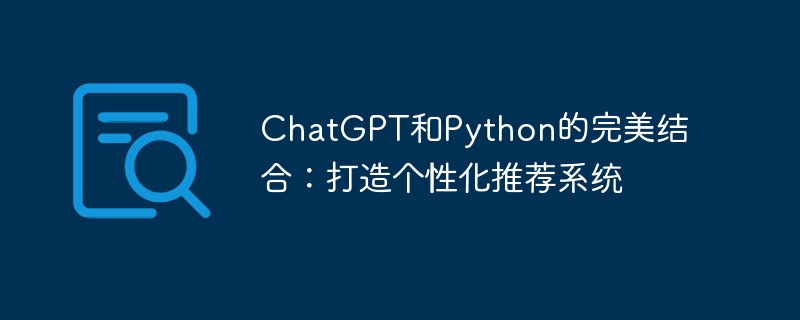

The perfect combination of ChatGPT and Python: creating a personalized recommendation system
Introduction:
In today's era of information explosion, people are increasingly relying on Recommendation system to obtain content and products of interest. The role of personalized recommendation systems is becoming increasingly prominent. By analyzing users' historical behaviors and preferences, they can provide users with personalized recommendation content and improve user satisfaction and stickiness.
In recent years, the development of language generation models has attracted widespread attention. OpenAI's ChatGPT model is one of the best. Its powerful language understanding and generation capabilities make it an ideal tool for building personalized recommendation systems.
This article will introduce how to use ChatGPT and Python to build a prototype of a personalized recommendation system, and attach corresponding code examples so that readers can further research and develop.
1. Data collection and processing
The first task in building a personalized recommendation system is to collect users’ historical behavioral data. This data can include users’ browsing history, purchase records, ratings, etc. In this article, we take a movie recommendation system as an example.
The following is an example of a simple movie rating data set:
user_id, movie_id, rating 1, 1, 5 1, 2, 4 2, 1, 2 2, 3, 3 ...
You can use the pandas library in Python to load and process this data set, for example:
import pandas as pd
data = pd.read_csv('movie_ratings.csv')2. Training the ChatGPT model
In building a personalized recommendation system, the task of the ChatGPT model is to generate movie recommendations that the user may like based on the user's historical behavior and preferences.
The process of training the ChatGPT model can be implemented through the transformers library in Python. First, we need to prepare a conversation dataset for training, which contains users' historical behaviors and corresponding recommendations.
The following is an example of training a dialogue data set:
[
{'user_id': 1, 'message': 'What are some good action movies?', 'response': 'I recommend watching "Avengers: Endgame" and "Mission Impossible: Fallout".'},
{'user_id': 2, 'message': 'Any romantic comedy recommendations?', 'response': 'You might enjoy "Crazy Rich Asians" and "La La Land".'},
...
]We can use this dialogue data set to train the ChatGPT model:
from transformers import GPT2LMHeadModel, GPT2Tokenizer, Trainer, TrainingArguments
tokenizer = GPT2Tokenizer.from_pretrained('gpt2')
model = GPT2LMHeadModel.from_pretrained('gpt2')
training_args = TrainingArguments(
output_dir='./results',
evaluation_strategy='epoch',
num_train_epochs=5,
per_device_train_batch_size=2,
per_device_eval_batch_size=2,
delete_checkpoints_on_save=True,
save_total_limit=1,
logging_steps=500,
)
trainer = Trainer(
model=model,
args=training_args,
train_dataset=dialogue_dataset,
tokenizer=tokenizer,
)
trainer.train()3. Personalized recommendations
After training the ChatGPT model, we can use it to generate personalized movie recommendations.
First, we need to get the user's input and pass it to the ChatGPT model for generation:
user_input = input("Please enter your message: ")
user_id = get_user_id() # 获取用户ID
input_ids = tokenizer.encode(user_input, return_tensors='pt')
output = model.generate(input_ids, max_length=100)
response = tokenizer.decode(output[0], skip_special_tokens=True)Next, we can generate responses from the recommendation system's data set based on the ChatGPT model , select the most relevant recommended movies:
recommendations = get_recommendations(user_id)
# 根据ChatGPT模型的回复,将推荐电影生成成一个列表
recommended_movies = extract_movies_from_response(response)
# 从推荐电影中选择用户可能喜欢的电影
user_movies = select_user_movies(recommended_movies, recommendations)
print("You might like the following movies:")
for movie in user_movies:
print(movie)IV. Summary and Outlook
This article introduces how to use ChatGPT and Python to build a prototype of a personalized recommendation system, and provides the corresponding code Example. While personalized recommendation systems meet user needs, they also bring many challenges, such as data collection and processing, model training, and interpretation of recommendation results.
In the future, we can further improve the personalized recommendation system, such as integrating more user information, optimizing model training strategies, introducing multi-modal data, etc. At the same time, more complex scene modeling and recommendation model research can also be conducted to provide more accurate and personalized recommendation services.
Reference:
The above is the detailed content of The perfect combination of ChatGPT and Python: creating a personalized recommendation system. For more information, please follow other related articles on the PHP Chinese website!




